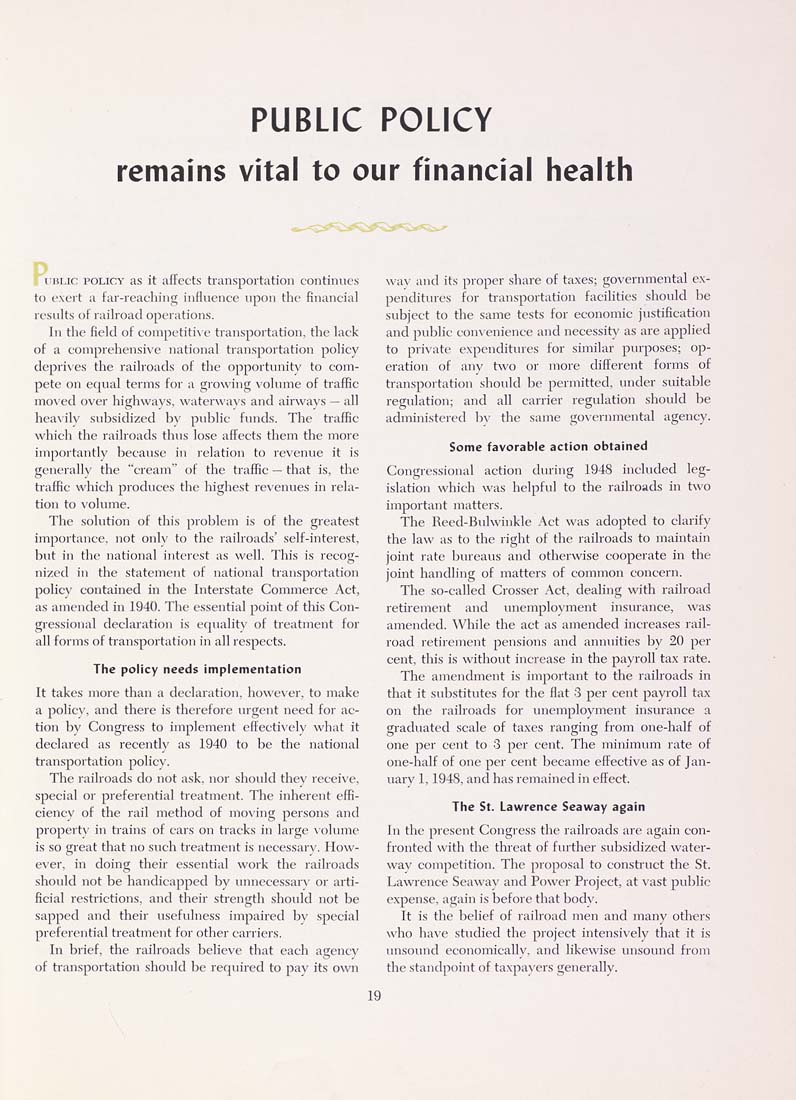PUBLIC POLICY
remains vital to our financial health
lUBLic POLICY as it aliccts transportation continues
to cxcit a far-reachitig inHuencc upon the financial
results of railroad operations.
In the field of competiti\e trauspoi'tation, the lack
of a comprehensive national transportation policy
deprives the railroads of the opportunity to com¬
pete on equal terms for a growing volume of traffic
moved over highways, waterwavs and airwavs — all
hea%'ilv subsidized by public funds. The traffic
which the railroads thus lose affects them the moie
importantly because in relation to revenue it is
generally the "cream" of the traffic — that is, the
traffic which produces the highest revenues in rela¬
tion to volume.
The solution of this problem is of the gieatest
importance, not only to the railroads' self-interest,
but in the national interest as well. This is recog¬
nized in the statement of national transportation
policv contained in the Interstate Commerce Act,
as amended in 1940. The essential point of this Con¬
gressional declaration is equalitv of treatment for
all forms of transportation in all ix'spccts.
The policy needs implementation
It takes more than a declaration, howe\'er, to make
a polic\', and there is therefore mgent need for ac¬
tion by Congress to implement effectively what it
declared as recently as 1940 to be the national
transportation policy.
The railroads do not ask. nor should the\" recei\e.
special or preferential treatment. The inherent effi¬
ciency of the rail method of moving persons and
property in trains of cars on tracks in large \'olume
is so great that no such treatment is necessary. How-
ever, in doing their essential work the railroads
should not be handicapped by unnecessarv or arti¬
ficial restrictions, and their stiength should not be
sapped and their usefulness impaii-ed by special
preferential treatment for other carriers.
In brief, the railroads believe that each agencv
of transportation should be required to pav its own
wa\- and its proper share of taxes; governmental ex-
pendituies for transportation facilities should be
subject to the same tests for economic justification
and public convenience and necessity as are applied
to private expenditures for similar purposes; op¬
eration of any two or more different forms of
transportation should be permitted, under suitable
regulation; and all carrier regulation should be
administered b\- the same govenunental agency.
Some favorable action obtained
Congressional action during 1948 included leg¬
islation \vhich was helpful to the railroads in two
important matters.
The Rced-Bulwinkle Act was adopted to clarify
the law as to the right of the railroads to maintain
joint late bureaus and otherwise cooperate in the
joint handling of matters of common concern.
The so-called Crosser Act, dealing with railroad
retirement and unemployment insurance, was
amended. While the act as amended increases rail¬
road retirement pensions and annuities by 20 per
cent, this is without increase in the payroll tax rate.
The amendment is important to the railroads in
that it substitutes for the flat 3 per cent payroll tax
on the railroads for unemployment insurance a
graduated scale of taxes ranging from one-half of
one per cent to 3 per cent. The minimum rate of
one-half of one per cent became effective as of Jan¬
uary 1,1948, and has remained in effect.
The St. Lawrence Seaway again
In the present Congress the railroads are again con¬
fronted with the threat of further subsidized water¬
way competition. The proposal to construct the St.
Lawrence Seawav and Power Project, at vast public
expense, again is before that bodv.
It is the lielief of railroad men and many others
who have studied the project intensively that it is
unsound economically, and likewise unsound from
the standjioint of taxpavers generallv.
|








